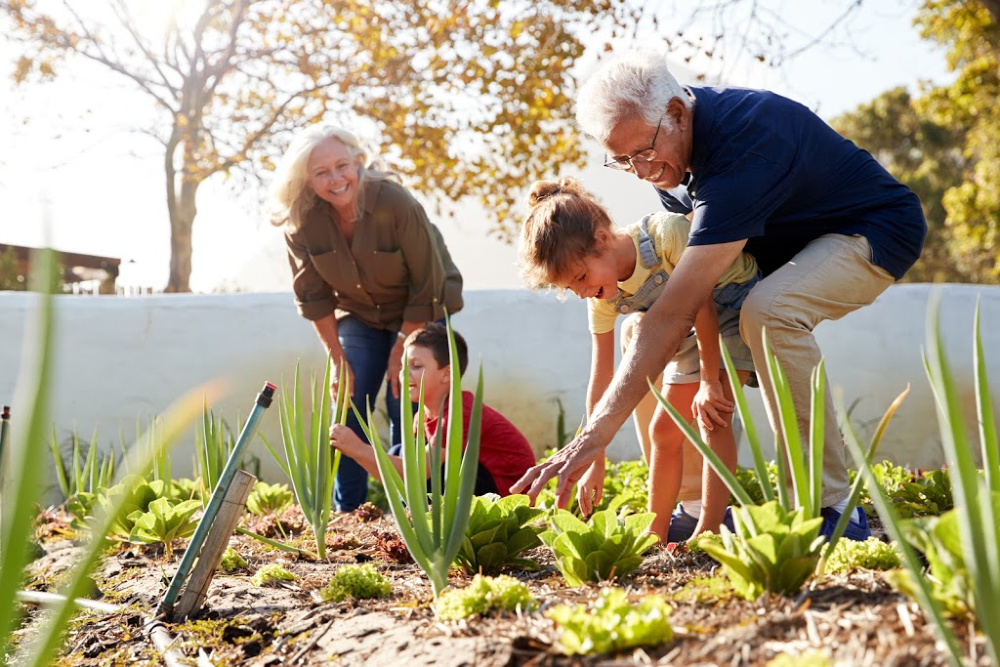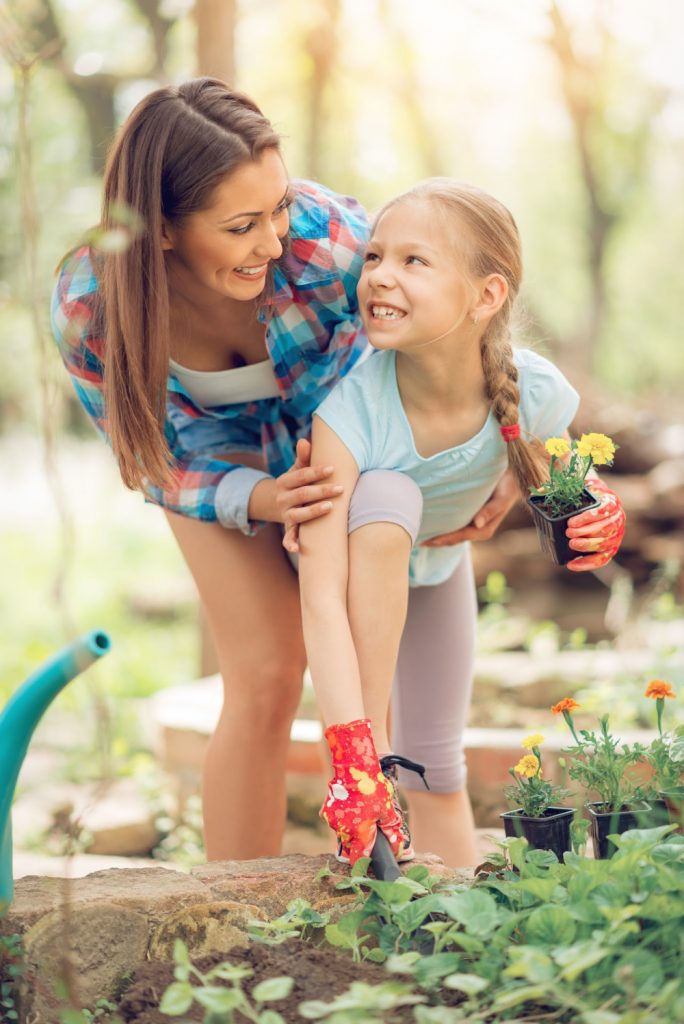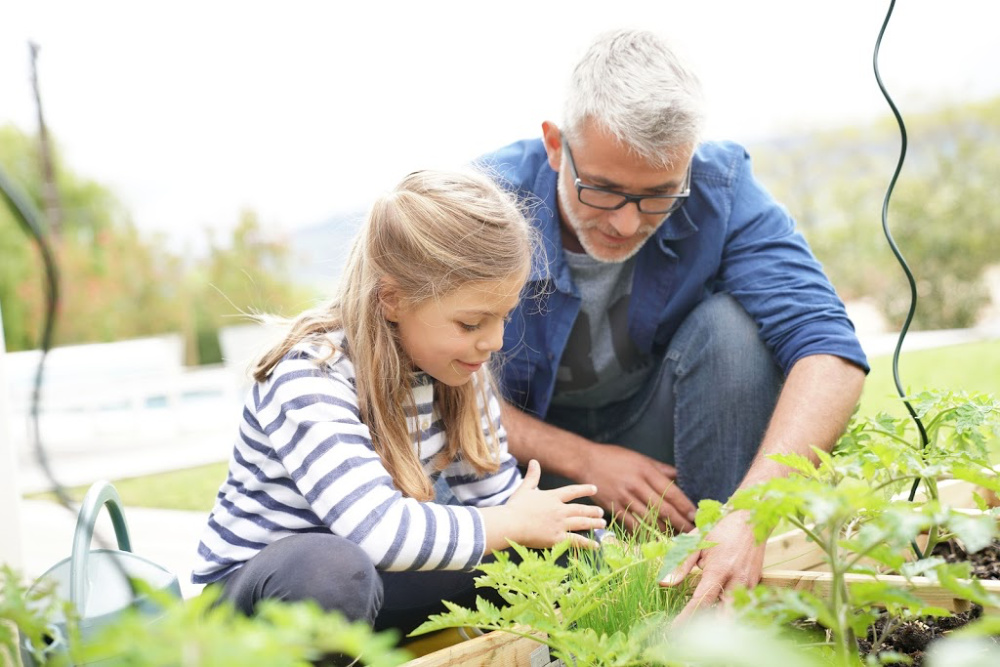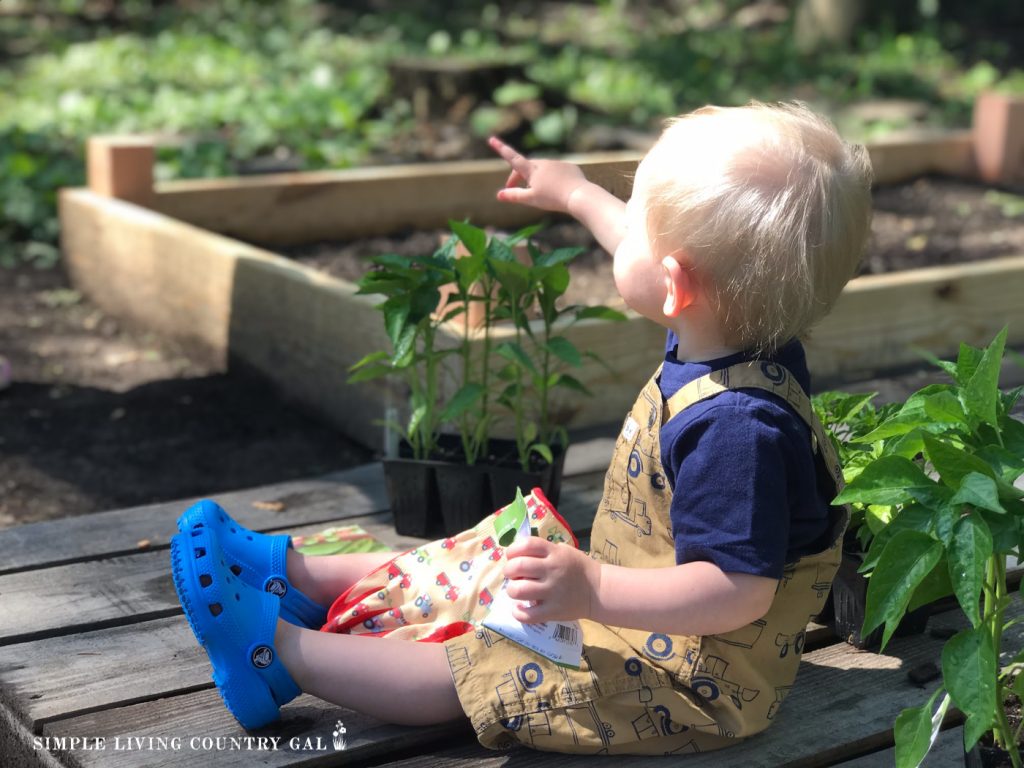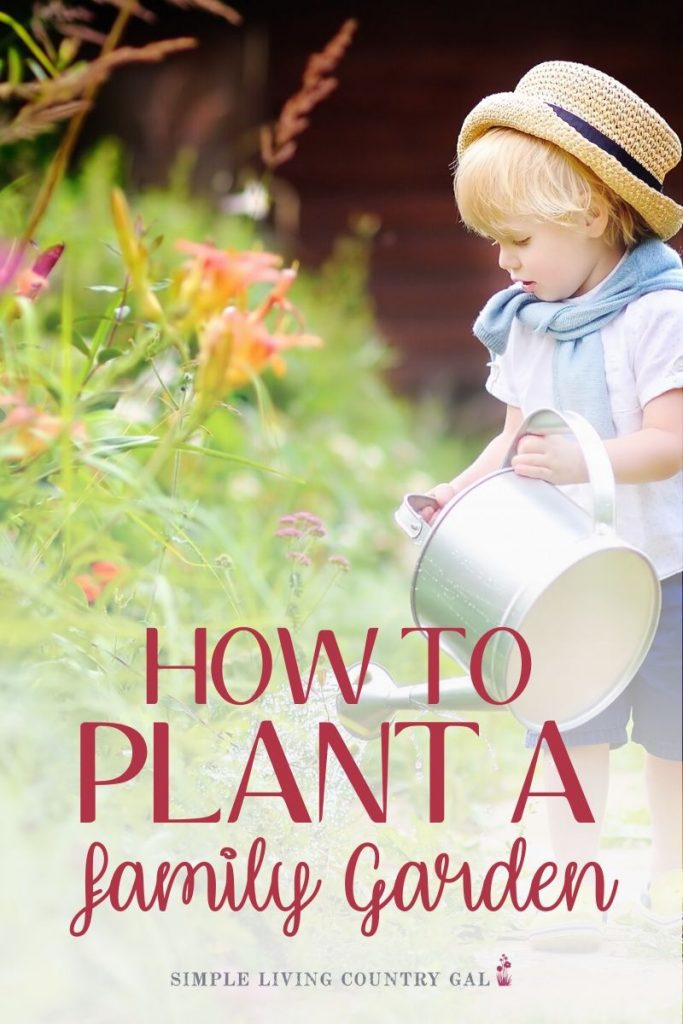The Benefits of Gardening with Children
A family garden created and cared for with your children is a great family activity and one that you can enjoy any time of the year. Your kids can plan their garden, plant seeds or bulbs, and harvest; all great activities they can do outside while getting fresh air and enjoying family time.
The Many Benefits Of Gardening With Children Include:
Engaging their senses – Children can dig in the dirt, add water to make squishy mud, watch their vegetables grow, and then get to eat them.
Encourage healthy eating – Your kids are more likely to eat veggies they grew themselves. They’ll take pride in their work and want to benefit from their accomplishments. You can let them try their fruits and veggies straight from the vine or take it a step further and let them help you prepare a meal with their harvest from the family garden.
Enhance fine motor skills – Between picking up tiny seeds, pulling weeds, and caring for their seedlings, gardening is a great way to help your child develop fine motor skills.
It’s scientific – What do plants need in order to grow? Why are leaves green? How much water is ‘just right’? These are all good educational questions you can use to teach your kids about the science of plants.
Creates family bonding time – Gardening together is the perfect family activity. More hands make the work easier and you can spend some quality time together. Decide on a theme for your family garden that everyone can enjoy. For instance, an Italian themed garden might include herbs and veggies that are perfect for pizza or pasta.
Teaches responsibility – Taking care of a family garden takes time, patience, and care. The garden needs to watered regularly, you need to make sure it’s getting enough light, and your plants are growing strong and healthy. These are great lessons in responsibility that can lead to other areas your child might have an interest in being responsible, for instance, adopting a pet. They can prove they’re responsible for a garden before the family adopts a new pet.
Improves math skills – How far apart do seeds need to be planted from each other? How many can you plant in a row? How much water do they need to grow? Planning a family garden encourages math skills and helps your kids put these skills to use in real life.
Teaches patience – It can take several weeks for a plant to grow from a seed, but your children will be able to see the process along the way and learn to be patient for the final outcome. Kids will learn that being patient is worth the wait.
With so many benefits of gardening with children, you may be ready to start planning your garden right away. But what are the first steps? What do you need to know? And what tools do you need? Don’t worry, I’ve got you covered. First, the tools.
Supplies For Creating A Family Garden
There are a number of tools you’ll need for your child-friendly family garden. Some you’ll find in a garden center, others in a craft store. You may even have several of these ideas in your house already.
- Long-handled shovels for digging
- Garden rake
- Long-handled hoe and cultivator
- Small hand-held trowels
- Small cultivator tool for breaking up hard areas of dirt and loosening weeds
- Tape measure
- Craft scissors for your child (adults can use pruners)
- Watering can
- Roll of string
- Wooden craft/popsicle sticks
- Plastic or wooden baskets (for harvesting)
- A towel or rubber kneeling pad
- Outdoor gear – hats, sunglasses, sunscreen
- Calendar for marking off the seed growth
- Notebooks, pencils, and markers
- Packets of seeds
- Gardening tools for young children
- Kid-sized garden gloves
Creating Your Family Garden
Now that you have your supplies, it’s time to plan your family garden and find the perfect spot for planting. This is a great activity for your kids; allowing them to be part of the planning process and getting outside.
Have your child scope out the area of your yard that gets the best sunlight for your garden. Here’s a great activity for that:
- Take your kids into the yard in the morning and give them each a notebook and pencil.
- Assign them each an area of the yard to watch, making sure you’ve assigned enough areas to find the best patch of land. Each area you’re considering should have enough soil to dig, should not be in a high-traffic area, and should be close to a water source.
- Have your kids note the current time in their notebooks and whether or not the sun is shining in their assigned area.
- Set a timer for 30 minutes then have them note the time and the amount of sunlight again.
- Repeat this process all day for an entire day until the sun sets.
- Have your kids add up the number of hours the sun shined in their area throughout the day.
- Talk through the options with your kids; the amount of soil, the amount of sunlight, how difficult it is to water, then vote on the best spot for planting. Make sure you weigh the pros and cons of each area to get the full picture.
A family garden that requires full sun will need at least six hours of direct sunlight. Three to six hours is considered partial shade, but it’s still good for some gardens.
If your yard gets less than three hours of direct sunlight in any one place, you may want to consider planting a container garden and placing the pots on wheeled bases so that you can move them around.
And, if you have complete shade in your yard, simply choose shade-friendly plants.
Once you’ve chosen the perfect spot, it’s time to decide how big your family garden should be. What you want to grow will help you figure that out. For instance, you can grow four heads of lettuce, 16 radishes, or one pepper plant in one square foot.
A good rule of thumb to follow when laying out your garden is that the width should not be deeper than twice the length of your child’s arm. This way, they can always reach the middle of the garden from either side.
Measuring and Marking Your Family Garden
Before you start digging, you’ll want to measure where your family garden will be and mark it to help you plan the proper amount of space. This is another great activity for your kids and will allow them to use their math skills. Working alongside is another benefit of gardening with children.
- Use a tape measure, string, and wooden craft sticks to mark off an area that’s about 4’ x4’ with a clearance of at least 2 feet on each side so that you can get around it.
- Have your child stand at the edge and reach their arm in. If their arm doesn’t reach the middle, you’ll need to make your garden smaller.
- You can also choose to make a round garden bed by measuring a 4-foot circle. Again, have your child reach in to make sure they can reach the middle.
Preparing the Family Garden Bed
- Using shovels, rakes, and hoes, remove any grass and weeds from the marked area. You may want to use them for compost later so just set them aside. You can save clumps of grass that have roots attached to repair any bare patches in your yard.
- Remove any rocks, weeds, roots, grass, and debris from the area. You may have to clear the area twice or dig a little deeper.
Planting Your Family Garden
Now you’re finally ready to plant! But what should you plant? You can choose a theme, like the Italian theme I mentioned, or choose some of your child’s favorite veggies. There are also some wonderful plants that are easy plants for kids to grow. These will require the least amount of work and your child will enjoy watching them grow.
Easy Plants for Kids to Grow
Sunflowers
These take up a lot of room so plant just one or two, but they’ll grow big and tall and beautiful; your child will love them. Sunflowers grow quickly, sprouting up in about a week, becoming a seedling by week two, and as tall as 2 feet within a month. Within two months, the buds will start to flower, revealing hundreds of little sunflower seed kernels. Make sure you choose ‘confectionery’ sunflowers as these are the type grown for food. They’ll dry naturally in the sun and be perfect for snacking on.
Nasturtiums
These beautiful flowers are easy to grow, come in a variety of colors, and are even edible so you can add them to a salad or use them to decorate a cake. They will bloom within 2 months of planting in your family garden and do well in poor soil and dry locations, but they do prefer sun.
Lettuce
Almost any kind of greens make for a reliable crop that grows quickly. They’re also a good way to encourage your kids to eat more salads. Lettuces usually prefer part shade with moist soil, especially for the first couple of weeks. A full head of lettuce will take about 45-60 days, although some varieties grow quicker. Head lettuce should be spaced about 8 inches apart while leaf lettuce only needs about 4 inches of distance.
Carrots
Carrot seeds can be planted directly into the soil and they like cooler weather. They can take a little longer to germinate but will mature in about 2 months. Make sure the soil is free of rocks so that the carrot has room to grow down. They only need about 3 inches of distance from each other, but they do need to be well-watered. The smaller varieties are recommended for children because they’re easier to grow and kids tend to enjoy eating them more.
Cherry Tomatoes
Kids usually love growing these so they make the perfect addition to your family garden. They will need full sunlight and you should plan ahead so that you can plant from seedlings instead of seeds. Place a 2-foot stake by each seedling as they’ll need to be loosely tied as they grow taller. Add lots of compost and water at ground level, but keep the leaves dry. The growing season is about 50-75 days. These are also a great plant for container gardens.
Potatoes
Potatoes are a vegetable you can’t get wrong. Both red and white varieties grow with ease, although red potatoes will mature faster. Simply cut seed potatoes into chunks with at least two ‘eyes’ per chunk. Plant about 12-15” apart with the eyes pointing up. Mound the soil up around the plant as it grows and when the plant collapses, you’re ready to harvest.
Snow Peas
Snow peas are a quick-growing vegetable and kids enjoy eating them right off the vine, which they can easily do since the pods are edible. They only take about 10 days to germinate and they’ll be ready to harvest in about 2 months. This veggie prefers cooler temperatures and partially shaded areas; they should be planted close together, an inch apart at most.
Pumpkin
What kid wouldn’t enjoy growing their own pumpkins in their family garden? They do take up a bit of space, but if you can spare it, they’re worth it. Seeds should be planted in a small mound of dirt. Poke three holes in the mound and place one seed in each hole. The seeds will start to sprout in about a week and the vines will begin to form a few days later and creep along the ground. Once you have three pumpkins on the vine, pick off any new blossoms.
They take a little longer to grow to maturity, about three to four months. They’re ready to be harvested with they feel hard on the outside and sound hollow when you tap them. Adults should always supervise the cutting since you’ll need shears. The pumpkin seeds can be dried for snacking on or to grow more pumpkins later. If you’re not carving the pumpkin, use the meat for a pumpkin pie or to add to some of your favorite recipes as it’s very nutritious.
A family garden is a great way to build a family bond, spend quality time together, and create memories that will last a lifetime. Your children may even pass down the gardening tradition to their own kids.
Regardless of the season, the amount of space you have, and the amount of sunlight your yard receives, there’s always something that’s ready to plant. Do you have tips on creating a family garden? Please share in the comments below!

